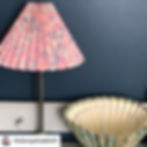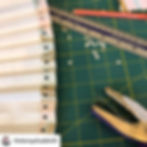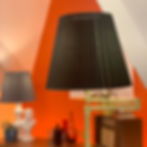Lampshade Style Guide - Pleated shades
- Dannells Admin
- Apr 6, 2022
- 4 min read
Updated: Apr 24, 2024
A lampshade style that’s hit the limelight in recent years, or should that be the spotlight, is the ‘hard’ pleated lampshade, defined by its knife pleat folds, that create a sharper and crisper looking shade than its soft shade fabric sibling. In this month’s Lampshade Style Guide, we look at the pleated shade’s origins, how versatile it is and tips for making one yourself.

A little bit of history
With help from David Mitchell from OrigamiHeaven.com, we’ve discovered that the pleated lampshades date back much further than you might think, with instructions to make a paper pleated lampshade found in a German paper folding book from 1876. It seems the style became popular in Europe and the UK, with the Victorians favouring the pleated lampshade style, often made of crepe paper or fabric. In more recent history they were ubiquitous in homes of the 1960s and 1980s.
The current resurgence of the pleated lampshade has been helped by designers such as Instagram’s Oscar Piccolo and Danish design house HAY, recreating this sturdy shade to fit into today’s homes.

Style Description
Not restricted by a specific traditional shape, the hard pleated lampshade can be made to sit at a variety of angles, from shades that look like an oversized cocktail umbrella (see Oliver Piccolo’s work above) to those that follow the shape of a traditional empire, with the option of angles anywhere in between. The structure and key to the pleated shade is of course its pleats, which again can be varied in depth and number that result in different looks, with the defined zig-zag edging being an essential part of the shade.
At the top of a pleated shade, the ring is most commonly attached via a series of holes that are punched out of the Lampshade Making PVC or paper, which are then ‘clipped’ onto the frame. The shade will often sit over a metal lampshade frame, such as a French Drum Frame or have a plain ring attached using the ‘clipping’ method or by glueing this into place inside the bottom of the shade.

Advantages and Uses
Pleated shades have the advantage of using either paper or fabric for the outer of the shade, meaning dependent on the texture or design you are looking for, you have options. Whatever light dispersion you want from your lampshade, this can be tailored by choosing the shape, such as coolie, empire or candle clip to suit either a pendant shade, table lamp or wall light.
When making a DIY Pleated Lampshade from either a Lampshade Making Kit or a combination of rings, the light fitting will differ. Our handy guide below, helps you explore what lampshade rings and frames you can use with the light fittings that work best for you.

Pleated Shade Making Tips
Whether you’re using paper or fabric you are making, here are our tips on creating crisply pleated lampshades
When making a pleated fabric shade, our Less Rigid Lampshade Making PVC is easy to fold and is ideal for lightweight cotton and linen. For medium weight fabrics, try our Standard Lampshade Making PVC.
Your lampshade material will need to be at least twice the circumference of the bottom ring. If using paper you may need to join strips together with a quality paper glue (try our Bookbinding Glue) and for extra support, a line of sewing machine stitches.
To create a crisp pleat, try a paper creasing tool or bone folder. A metal ruler can also be useful for marking the pleats, but also for applying pressure to the pleat afterwards, by simply laying the ruler over the edge, helping the pleat to stay in place.
A belt punch is a good investment as on both fabric and paper shades each pleat needs to be punched with a hole, that will fit over the 3.25mm gauge epoxy coated steel rings of our frames.
For paper shades, you’ll need to consider the weight of the paper which is measured by gsm. Ideally, you are looking for a crisp pleat that will hold but that’s not too heavy and taking a lead from origami lampshade makers explore paper between 160 and 220 gsm to see which you prefer.

Accordion Pleated Lampshade Sleeves
If you love the look but don’t have the time to make a pleated shade, we’ve done the hard work for you! Our range of Pleated Lampshade Sleeves come in four sizes and have been designed to clip onto our range of French Drum Shades. Made using our popular Chic fabrics, there are nine choices of fabric outer including effortless neutrals; white, off white, cream, black and navy and more trend lead shades; scarlet red, dark grey, bottle green and indigo blue. To find out more read our Accordion Pleated Lampshade Sleeve blog post

Cleaning a Pleated lampshade
Once in a while, every lampshade needs a clean, so for paper shades, we’d advise a microfibre cloth for gently cleaning between the folds. For a fabric version, a dry paintbrush is an easy way to brush away any dust, and if you have a brush attachment for your vacuum cleaner this can be effective too. If your shade has attracted any stubborn stains our Lampshade Cleaning Foam is a versatile foam pad that is brilliant for cleaning dirt, dust, pet hair and lint from lampshades. Working in a similar way to a pencil rubber, it wears away as it cuts through dirt, it leaves a slight residue which can then be rubbed off with a damp cloth.

#pleatedshades #paperpleatedshades #hardpleatedshades #lampshadestyleguide #empirelampshademakingkits #coolielampshademakingkit #lampsahdemakingkits #shadehistory #lampshdehistory #pleatedtablelamps #pleatedpendantlamps #pleatedwalllights #bonefolder #lessrigidlampshademakingPVC #lampshademakingPVC #professionallampshades #bespokeshades #uniqueshades #lampshades #lampshademaker #bespokedesign #oneofakindshade #handmadeshades #lampshademaker #lampshadeinspiration #creativeshades #creativeprocess #creativelearning #craftbusiness #shademaker
(small).jpg)

